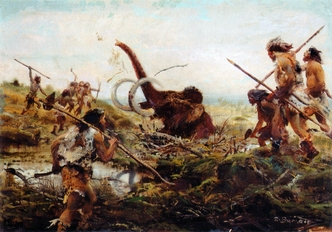Ever wonder how natural instinct aided in our species’ remarkable triumph against the endless dangers of the Paleolithic Age? We should not underestimate the amazing feat of our ancestors’ success in overcoming the scarcity of vital resources and their ability to withstand traumatic encounters with treacherous wildlife. With that in consideration, our predecessors’ ability to analyze, adapt, and overcome obstacles ultimately resulted in the prosperity of our species.
In our most adolescent years of species development, our ancestors established unique methods in conquering the colossal tasks of surviving in the Stone Age. To compensate for their small structure, Paleolithic hominids used simple resources to craft efficient weapons, and applied their intelligence to create impeccable coordinated attacks. Studying the individual and group behavior of their prey enabled our prehistoric hunters to discover new hunting strategies. Through critical thinking, it influenced their decision in choosing the best time to strike their prey so as to ensure positive outcomes from their attacks.1 Their persistence, planning, and effort resulted in the recurrent and inevitable demise of their prey. The types of animals that were chosen in hunts often depended on their size and aggressiveness. In order to continue providing for the hunter-gatherer community, hunters kept wary of the possible risks that came with hunting dangerous animals with dangerous reputations, such as Woolly Mammoths, Woolly Rhinoceros, and Cave Lions. Hunters invented ranged weapons in order to compete with their prey, which changed the necessity of close contact with these large beasts, and really opened up their options in creating more intuitive attacks. This new method of ranged hunting allowed them to attack from safe distances, and ultimately minimized the dangers that came with hunting more rewarding animals.
Hunters were assigned different types of weapons depending on the body type and size of the hunters. This method was established to maximize damage efficiency and control over the advantageous weaponry. Spear throwers were usually tall hunters with proportionally longer arms, which gave them greater leverage and control. Smaller hunters typically used bow and arrows, which did not require long arms, and their training allowed them to master this much more precise and sophisticated approach.2 Attacking in large hunting groups allowed hominins to overwhelm and defeat their much larger prey. Hunting larger animals came with greater risks, but the possible rewards and resources that were obtained through conquering these enormous animals balanced out the possible fatalities: the bigger the risk, the bigger the reward.3

Some of the weapons utilized in these prehistoric encounters were primitive tools made from the simplest materials such as rocks, sticks, and bones. Although wood was much available, bone was preferred when due to its density, strength, and the convenience in being to able to mold it easily. Hominins used animal bones to create spear tips and arrows that would last much longer than the original method of using wooden spear tips.4 Through their inexpensive and useful resources, they were able to create effective hunting tools in small amounts of time, resulting in the discovery of the traditional throwing spear, the bow and arrow, and hunting traps. Their innovative weapons were designed to incapacitate a great variety of animals, and did so with much more efficiency.
Through the astounding accomplishments and efforts of our ancestors, their revolutionary inventions and mental growth has allowed us to thrive in our world, and has helped us develop into the dominant species we are today. Without our ancestors abilities to strategize, coordinate, and desire to survive, our existence would have been wiped off the face of this Earth many million years ago.
- Gerrit Leendert Dusseldorp, “Studying Prehistoric Hunting Proficiency: Applying Optimal Foraging Theory to the Middle Paleolithic and Middle Stone Age,” Quaternary International, 252 (February 2012): 4. ↵
- David W. Frayer, “Body Size, Weapon Use, and Natural Selection in the European Upper Paleolithic and Mesolithic,” American Anthropologist 83, no. 1 (1981): 58. ↵
- Mary C. Stiner, “An Unshakable Middle Paleolithic?,” Current Anthropology 54, no. S8 (2013): 289-290. ↵
- Marina Évora, “Osseous Industry and Exploitation of Animal Resources in Southern Iberia during the Upper Palaeolithic,” Quaternary International, 318 (December 18, 2013): 36-38. ↵



37 comments
Seth Roen
The Stone Age was not an enjoyable time to live for our ancient ancestors. For we were not the dominant species that some would like to think were, even in our earliest history. We as a species have come so far since then. From a lawless time and a stone was the most powerful tool at our disposal. To a world with laws and tools that would make our ancestors consider us as gods.
Amelia Hew
It’s amazing on how our species during the Paleolithic Age was able to hunt prey almost a few times their size with primitive weapons made of stone and sticks. They were even able to customize their weapons according to one’s size or height in order to achieve successful hunts and they even made more creative weapons and animal traps. In some cases, I might just say that if we were in their situation we might have a harder time on completing the hunt to sustain ourselves and that just made people from the ancient times more admirable.
Sebastian Azcui
It is amazing how time has changed things. How humans evolved and progressed a lot. Now a days we are very different from our ancestors as we have developed many new things and progressed so much in little time. Reading about our ancestors seems really cool and getting to learn how they lived. With their intellectual level, it is impressive to read and learn how they managed to hunt with some weapons and how they managed to survive by hunting animals.
Roberto Rodriguez
This article brings into the light that it is easy to forget that tool-making is a very useful and advanced skill that very few animals have come to master. It also takes great motor skills and great hand-eye coordination to use tools effectively as well as communicate with others to take down a bigger animal. All of this would not be possible without the development of our brains through a vast amount of time and evolution. We forget that hominids have been on this earth for thousands of years, but we also forget that there are other organisms that were/have been on this earth a lot longer than us.
Hali Garcia
It is truly fascinating learning about how humans have evolved. I love watching documentaries about the ancient hominids because I love seeing how they would survive. They relied on the environment, and critical thinking to create their lives. The hominids would study their prey in order to hunt and they would they would make their weapons out of whatever material they had.
Noah Bolhuis
Reading and learning about our ancient ancestors has always been deeply fascinating, and I really shows why humans are where we are. With critical thinking, and using our environment to help us, and use it in different ways, we were set apart from the rest. The ability to bring down massive prey wouldn’t have been possible without these ranged weapons, or we would have been setting ourselves up for great failures and losses. Because of these ancient hominids, we are able to be at the top of the food chain and able to group our population because of more available food.
Destiny Flores
Through thousands of years of evolution, since some of our first ancestors, we as humans have developed so much intellectually, it’s sometimes easy to forget our primitive past and the fact that we may still hold some of that primitive nature within us. I found this article very informational about how our very foundation of life, and how were still here today, relied so much on hunting-something seen today as a sport.
Clarissa Bustamante
Great article! It is pretty cool how our ancestors went head to head with such big animals. It’s very fascinating how they would strategically hunt for their prey. I didn’t know that weapons were assigned depending on their body type. And the fact that they would risk their lives in order to eat themselves. It is cool to know that they were able to survive and grow in such harsh conditions.
Megan Barnett
I liked how you were able to write this story with more excitement than what I thought it offered. I already knew most of this information but I had no idea that there was such an animal as a woolly rhinoceros. The different sized weapons was also a concept I had never heard of but found interesting that even then people were separated based on their differences, however this was better as they used their differences to work as a team.
Mario Sosa
It is always so fascinating to read about how our ancestors lived throughout the Stone Age. I learned a great deal of info on how our ancestors hunted, such as how the type of weapons they used depended on their body type and size. One thing I thought was interesting was how much planning and strategizing went into hunting down larger, dangerous mammals. Great article, good job!